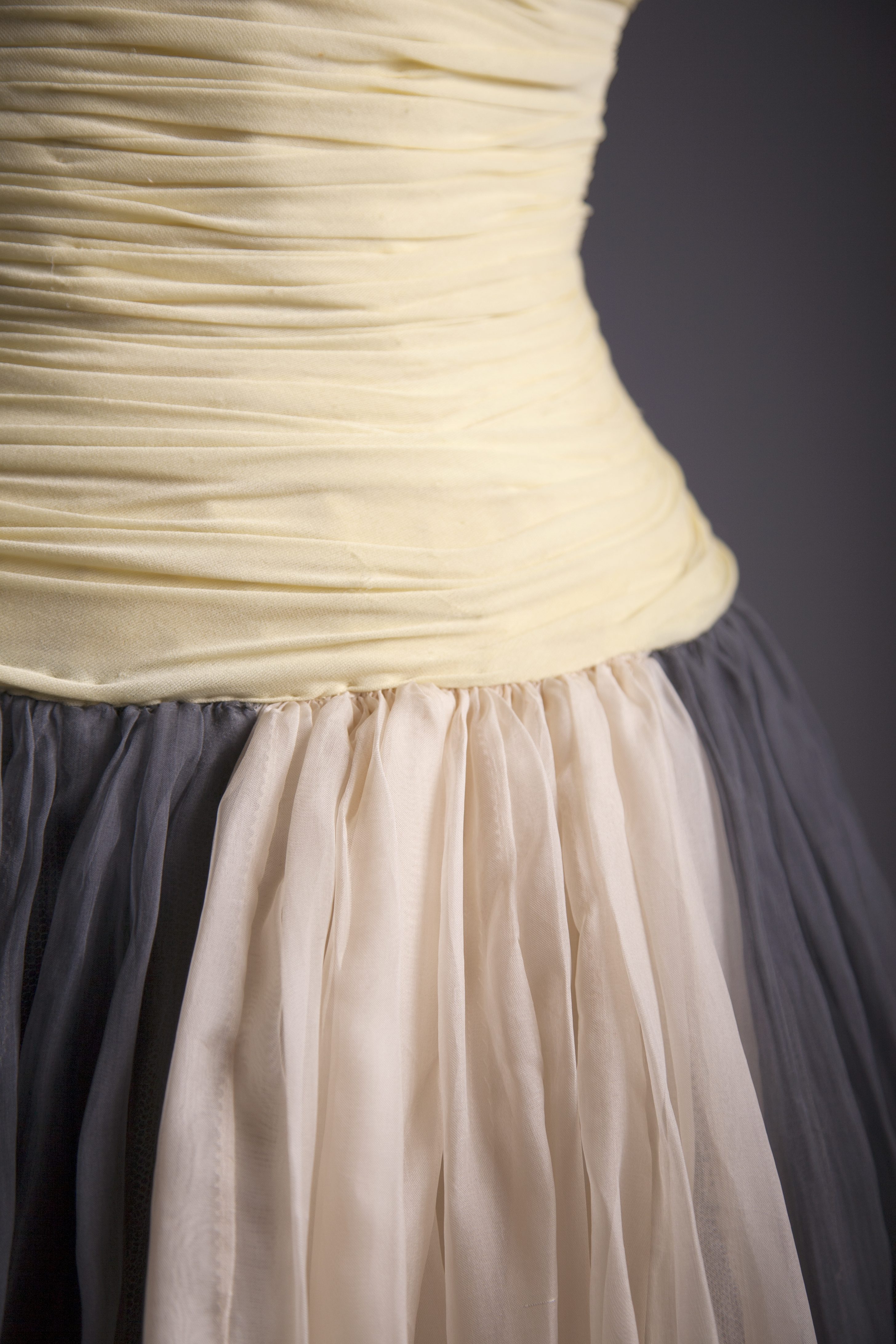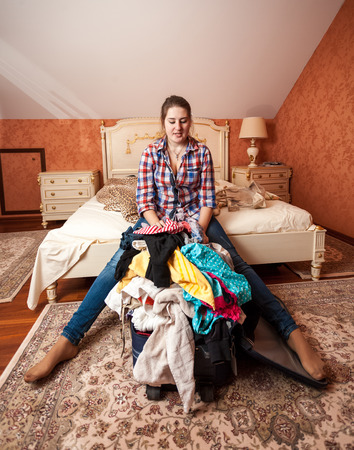
How Deep Does this Closet Go?

ART
An exhibit at the Michener exposes a bit more of Drexel’s legendary fashion collection. But even its curator doesn’t know exactly what she’s sitting on.
By Scott Edwards
 In spite of the elite names featured among its ranks—Chanel, Dior, Givenchy—what is now known as the Robert and Penny Fox Historic Costume Collection spent almost all of its 125 years locked away from the public eye. It was used as a teaching tool at Drexel University, in Philadelphia, where the collection is housed.
In spite of the elite names featured among its ranks—Chanel, Dior, Givenchy—what is now known as the Robert and Penny Fox Historic Costume Collection spent almost all of its 125 years locked away from the public eye. It was used as a teaching tool at Drexel University, in Philadelphia, where the collection is housed.
“It wasn’t until the late nineties that some of my colleagues here started nosing around what we had,” says Clare Sauro, who joined Drexel in 2008 and serves as the collection’s curator. “It really kind of dawned on Drexel that they had an amazing asset here, and maybe something more could be done with it.”
A.J. Drexel invested $1 million shortly after he founded the school in 1891 to start an art collection that would include textiles. His expectation was that it would eventually evolve into the school’s own museum. Aside from his seed money, Drexel also rallied his friends and family to donate. “So, we were getting donations from prominent Philadelphia area families, but really and truly, most of them lived out on the Main Line,” Sauro says.
 In 2013, another million-dollar investment changed the collection’s purpose. This one came from the Meadowbrook couple after which the collection is now named, and it enabled Sauro and the university to begin thinking on a grander scale. That movement began to come to fruition last October when the collection made its public debut. “Immortal Beauty: Highlights from the Robert and Penny Fox Historic Costume Collection” put 75 pieces focused largely on international high fashion from the 20th century on display at Drexel’s Antoinette Westphal College of Media Arts & Design.
In 2013, another million-dollar investment changed the collection’s purpose. This one came from the Meadowbrook couple after which the collection is now named, and it enabled Sauro and the university to begin thinking on a grander scale. That movement began to come to fruition last October when the collection made its public debut. “Immortal Beauty: Highlights from the Robert and Penny Fox Historic Costume Collection” put 75 pieces focused largely on international high fashion from the 20th century on display at Drexel’s Antoinette Westphal College of Media Arts & Design.
And in March, another exhibition, “Philadelphia in Style: A Century of Fashion,” featuring an entirely new selection, opened at the James A. Michener Art Museum in Doylestown. (It will remain on view through June 26.)
“You’re speaking to me at a very interesting point in our history,” Sauro says during a phone interview in the midst of preparing the Michener exhibit. “Also thanks to Robert and Penny Fox, we have started planning our own dedicated galleries. I mean, we won’t be able to do grand, gorgeous exhibitions like what you’re going to see at the Michener. But small, lovely exhibitions on the regular from us would be a dream come true.”
 As will actually knowing what she’s preserving. Sauro and her staff recently began cataloguing the collection—the first time its been done in its history. But that was put on hold when the funding for last year’s exhibit came through. At this point, everything from the Drexel and Michener shows has been accounted for. Which only leaves an estimated 13,900 pieces to go.
As will actually knowing what she’s preserving. Sauro and her staff recently began cataloguing the collection—the first time its been done in its history. But that was put on hold when the funding for last year’s exhibit came through. At this point, everything from the Drexel and Michener shows has been accounted for. Which only leaves an estimated 13,900 pieces to go.
“It’s going to take a long time,” Sauro says. And there’s no way around it. “In this digital world, if you don’t have a searchable database online, you might as well just not exist.”
Maybe the Foxes’ donation wasn’t such a blessing after all.
I read that Greta Garbo is among the collection’s donors. Are there any others of her caliber?
Sauro Actually, that’s not exactly correct. We have a dress that was worn by her. We also have a dress that was worn by Joan Crawford from the same period, but it was donated by a local family. We do have some pretty big names, though. We have a fantastic coral-encrusted gown that was donated by Princess Grace of Monaco. That’s probably the biggest get that we have.
So if I made you name a single crown jewel for the collection—and I am—you’re going with Princess Grace’s gown?
I would say that’s probably the most beloved piece in the collection. Princess Grace gave it to us in 1969. There are really only two things that people ask for. They want to see Garbo and they want to see Princess Grace.
Are there any local ties to any of the pieces featured in the Michener exhibit?
Yes. It’s a very local exhibition. The idea was, tell the story of fashion here in Philadelphia and the Philadelphia region for a hundred years. We’re covering a period from 1895 to about 1995. And it is focused on shopping and—basically, everything in the exhibition was either worn here in Philadelphia by somebody that we can document was wearing it in this area or purchased here. We have a handful of pieces that were made here as well.
Anything with an especially exotic lineage?
I am particularly fond of a pink tulle evening gown from 1916. It is almost certainly a French design. It is from the couture house of Callot Soeurs. I think it was purchased in Paris because it required multiple fittings and things like that, although they were sometimes imported. I know it’s a very expensive dress. It’s kind of this crazy fairy-princess dress. So I feel like that may be one of the things that people are really taken with because it’s so unexpected. It’s not really an exotic show. It’s a happy show—a spring-timey, optimistic, colorful show.
Why?
The color palette, the general mood. I have a little psychological quirk that I like to do springtime items on display in the springtime. [Laughs.] No heavy furs or velvet or anything like that. Lighter materials, lighter colors, lots of flowers—yellow, and navy blue and pink.
In the context of all that you’ve come across in your career, where does this collection fall?
It’s a difficult question to answer in that we’re currently operating without a true inventory, so my sense of what we have is based on what I’ve seen and what I know. I’ve been in this field for a long time. I was at the Museum at the [Fashion Institute of Technology] before I came to Drexel, which is a fabulous collection. And while we’re not as big as that, and they certainly have us beat in the realm of modern fashion, we have exceptional examples of early-20th century high fashion. We have some really unusual designers. We have really exceptional high-quality items. We have a museum-caliber collection in a university research setting, which is an interesting thing to be the caretaker of.
Did the Drexel exhibition draw any new pieces out of the woodwork? How frequently are you receiving donations at this point?
It kind of ebbs and flows with the tax year. [Laughs.] But we have had a steady increase of donations in the last three years. We moved to a wonderful new storage space here in the URBN Center. And once people could see what we had in that space, they got excited. We started getting amazing donations. I don’t know exactly how many we’re getting a year, a couple of hundred, certainly. So we are growing at a quick pace.
Do you ever turn anything away?
Sure, sure. That is probably the worst part of my job because people hold onto things for a reason. They mean something to them—their mother’s hat, their wedding dress. But there are just certain categories we have a whole lot of. We have a lot of children’s wear and we have a lot of wedding dresses. And women’s fashion from the 1960s on, we’re fairly plentiful. So I have to be very particular because we are in an urban environment and space is not unlimited.
Is there an elusive piece that you’re holding your breath for?
Oh, there’s a whole bunch of them. I have a running list in my head of gaps that I’d like to fill. After the inventory is done, I’ll have a better sense of what we need. I know we need more of the Japanese avant-garde designers from the late seventies on. They’re just not coming to us. If someone out there is a Yohji Yamamoto collector and wants to clear out his closet, that would be great. [Laughs.] But there are holes that I have identified. Another one, and I really hope you put this is in because they might be out there, for whatever reason, we don’t have Claire McCardell in our collection, and she was a fantastic and important American designer. She wasn’t fine couture, but her cuts, her construction methods, she was very innovative and very clever.
[divider]The Fox Costume Collection by the Numbers[/divider]
14,000+ Total number of garments, accessories and textiles (estimated)
5 Gap in centuries between the collection’s oldest piece, a fragment of 16th-century Italian velvet, and its newest, a 2012 evening dress designed by Alexander Wang
125 Age (approximate) of the collection
26 million Today’s equivalent of what A.J. Drexel invested in starting the collection
84 Total number of pieces featured in the Michener exhibit—34 full garments and 50 accessories
Photos courtesy Drexel University










